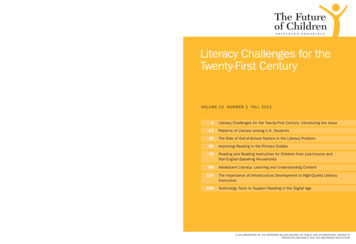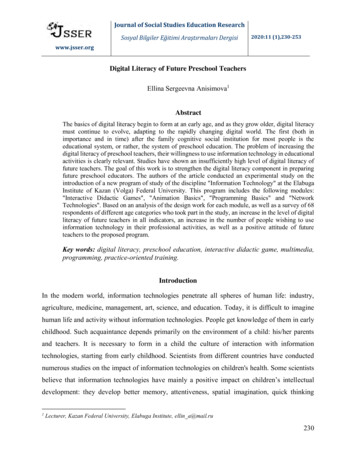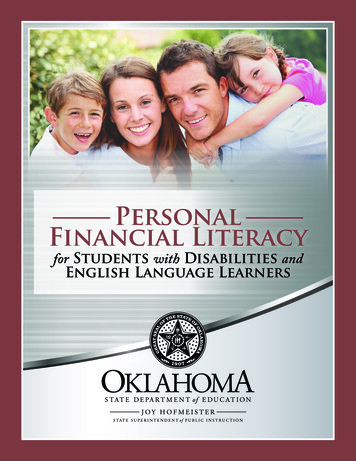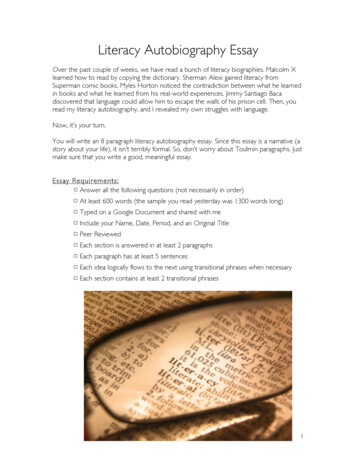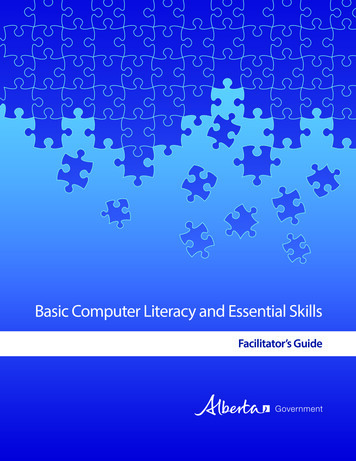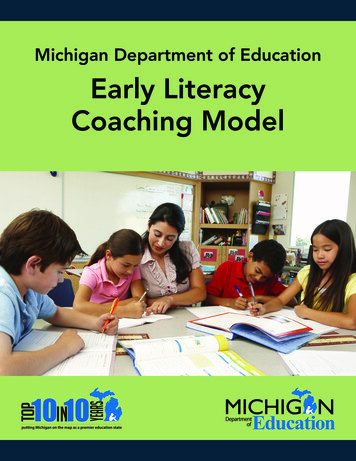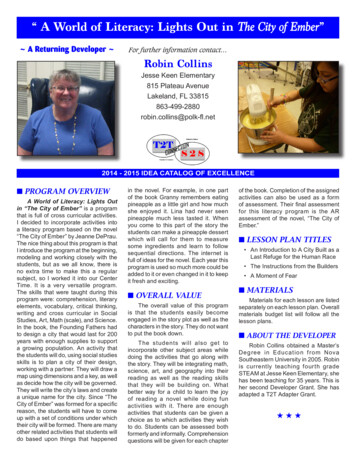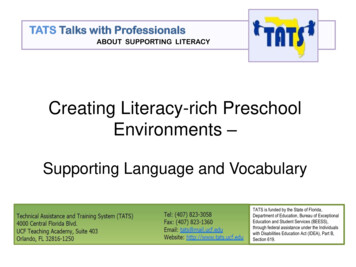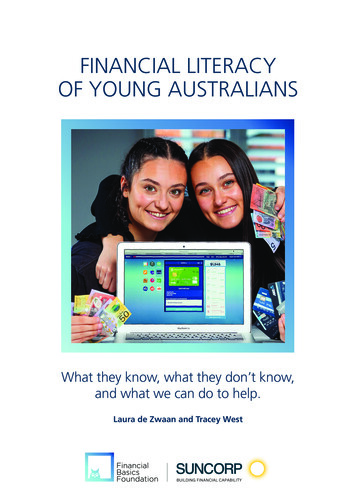
Transcription
FINANCIAL LITERACYOF YOUNG AUSTRALIANSWhat they know, what they don’t know,and what we can do to help.Laura de Zwaan and Tracey West
DedicationJoe Cole was Honorary Treasurer of the Financial BasicsFoundation for five years, from July 2013 to April 2018. OnJoe’s untimely death in 2018, the Financial Basics Boardresolved to honour Joe’s commitment to the financialliteracy of young people through establishing a perennialresearch project, to be called the Joe Cole Monograph.The research is published in a series of monographs thatexplore the state of financial literacy among young people,and its potential to enrich their lives through deeperunderstanding of how to manage their finances. Themonographs are intended to be published widely, rangingfrom financial and tertiary institutions through to schools,families and carers.Joe Cole knew the power of education in enhancingthe ability of young people to fulfil their potential andpursue their dreams. It is the hope of the Financial BasicsBoard that this initiative will build on Joe’s optimism bycontributing to that potential, and nurture at least some ofthose dreams into reality.
About the authorsLaura de Zwaan PhD is a lecturer in Finance and FinancialPlanning at Griffith University in the Department ofAccounting, Finance and Economics. She completed her PhDat Griffith University in 2013 in the area of superannuationand ESG investing. Laura’s research interests encompassmost areas of superannuation, including fund investmentpolicies, member decision-making, gender issues, taxation,and fund governance. In addition, she has a strong interestin financial literacy and capability, especially with regards tovulnerable cohorts. She has published widely in journals suchas Critical Perspectives on Accounting, Accounting, Auditingand Accountability Journal, Financial Services Review, and theJournal of Australian Taxation.Tracey West PhD is a lecturer in Finance and Financial Planningin the Griffith Business School. Tracey has a strong backgroundin household finance, with several publications on householdfinance, financial literacy and financial planning issues,including a PhD thesis completed in 2016. Recent work hasbeen published in Economic Notes, Financial Counselling andPlanning, Financial Planning Research Journal, Journal ofFamily and Economic Issues, JASSA, the Consumer InterestsAnnual. This work contributes to knowledge on investorbehaviour, informing curriculum development and guidancefor advisors in the financial services industry. She currentlyteaches Behavioural Finance and Wealth Management atGriffith University, Australia.FINANCIAL LITERACY OF YOUNG AUSTRALIANS / 1
Executive SummaryYoung Australians have been identified as having low financial literacy. This has led toincreased efforts to improve these levels, in particular, the inclusion of financial literacyin the Australian Curriculum. This research was commissioned to investigate why youngwomen, compared to young men, have poorer levels of financial literacy.To investigate this issue, interviews and focus groups were conducted at four Queenslandschools; two in a regional area, and two in an urban area. In total, 16 focus groups and32 interviews were conducted. These were analysed using thematic analysis.Key findingsa)Students generally do not know a lot about personal finance.While some students were aware of financial concepts such as interest, inflation, investing, insuranceand superannuation, most had little or no knowledge and/or understanding of personal finance.b)Students predominantly learn about money and financial concepts from home, Maths, orBusiness Studies.Most students identified learning about money at home, however many recalled learning about interestand shares at school in Maths. Business students were by far more informed than other students. Makingfinancial concepts assessable results in more engagement.c)For many students, Maths is not the most effective curriculum area for learning about personal finance.Maths tends to result in students fixating on formulas and calculations without understanding theunderlying concepts. Many students also dislike Maths, resulting in more disengagement.d)Most students appear to be good savers, however there is evidence that this is passive rather thanactive, and they are just not spending their income.Most students spoke about how much they had saved, however on closer examination, thesestudents do not have a lot of expenses. Discussions with older students who did have expensesrevealed that they did not always know how to moderate spending in order to save.e)Stories are important for learning.Students who could recall financial concepts would often be recalling an experience orsomething from history when talking about it. This indicates that stories may be more effective incommunicating financial concepts.f)Context is really important.It is important to match the learning activities with what the students are experiencing, and to usereal life scenarios.g)Home life can have a huge impact.The students we spoke to were incredibly diverse. There is huge variation in the structure of theirhouseholds, with many not living with their parent/s. There is also evidence of parents not beingable to provide financial guidance.2 / FINANCIAL LITERACY OF YOUNG AUSTRALIANS
h)There are gender differences.Compared to boys, many girls have less confidence in themselves when it comes to financialknowledge. They may also have a more collective approach to finances where they considerothers when making financial decisions. Girls also require more context when consideringfinancial questions to understand what the question is asking, and as a result we find girlswould benefit from other forms of assessment.i)There is less evidence for regional differences.While regional differences were evident, it is most likely these are driven by socioeconomic background.Given the research findings, we make the followingrecommendations:1.Given the importance of financial literacy for student wellbeing, financial literacy educationshould be elevated within high schools. Ideally this is within in a standalone program,however we should also seek ways to inject principles of financial literacy into as manyareas as possible across the curriculum. In particular look for opportunities in the wellbeing/pastoral care area of the school’s offerings.2.The delivery of financial literacy education in Maths needs to be improved. A range ofapproaches – not limited to calculation activities – should be implemented to addressfinancial literacy.3.Delivery of financial literacy education should be expanded to subjects outside of Maths andBusiness, in line with shifting the focus from financial calculations, to financial concepts.4.A range of assessment methods should be offered to students to enable them to show whatthey have learnt. Assessment tasks should be varied in nature, going beyond calculations.Tasks could include written pieces, visual or dramatic presentations, or oral explanations.These could be group presentations as well as by individuals.5.Learning activities should be aligned with the general level of financial experience ofthe students.6.Students need more exposure to effective financial strategies, in particular moderation(or control) of spending for saving.AcknowledgementsThe authors would like to acknowledge the time and effort of the schools that volunteered toparticipate in this research project. This includes the Principals, Heads of Departments, Deans, andTeaching and Support Staff. These staff members went above and beyond to accommodate ourefforts to complete this research. We also thank the students who gave their time to this projectand provided honest responses to all of our questions.FINANCIAL LITERACY OF YOUNG AUSTRALIANS / 3
ContentsAbout the authors1Executive Summary2Acknowledgements3List of Tables6List of Figures6Introduction7Study Method9Ethical Clearance10Background on Schools10Research Approach11Data analysis12FindingsWhere they learn about money1313Parents13Maths, Business and Accounting13Other subjects14Media14Work14Financial decision-making14Maths15A lack of knowledge16Knowledge of financial concepts16Savings16Loans17Credit lation20Insights20Calculations are probably not the best approach20The importance of stories21The importance of context22The impact of home life234 / FINANCIAL LITERACY OF YOUNG AUSTRALIANS
25Gender differencesPerceptions of gender differences25Girls and spending25Confidence25Social constructs and financial knowledge2627Regional differencesResponsibilities27Knowledge of money2728Survey resultsDemographics28Self-rated abilities30Attitudes towards money31Financial behaviours33Financial products35What have they learned at home?35Preferences for learning36Gender Analysis3648What can we do to help?At School48At Home4950ConclusionsOffer a financial capability subject50Improve delivery of financial literacy in Maths50Use different approaches to learning50Continue to use assessment, but change the focus50Match context to students51Financial literacy outside of Maths52Learn how to actually save52School Resources52Limitations53References54Appendix A56Appendix B58FINANCIAL LITERACY OF YOUNG AUSTRALIANS / 5
List of TablesTable 1 Number of Focus Groups and Interviews at each School12Table 2 Respondent demographics28Table 3 Financial concepts learned at home35Table 4 Financial concept preferences for learning36Table 5 Cross-tabulation of gender by difficulty in managing finances37Table 6 Cross-tabulation of gender by organised with managing finances38Table 7 List of interview and focus group codes57List of FiguresFigure 1Conceptual Framework for youngAustralians’ financial literacy and capability9Figure 20 Organsied with managing financesby gender39Figure 21 Avoidance of financial situation by gender39Figure 2Subjects studied at school28Figure 3Carer/s’ financial situation29Figure 22 Purpose of money by gender40Figure 4Hours of paid work29Figure 5Self-rated financial literacy30Figure 23 Confidence in financial managementby gender40Figure 6Self-rated ability to manage money30Figure 24 Balancing income and expensesby gender41Figure 7Coping Financially31Figure 8Difficulty in Managing finances31Figure 25 Savings intentions41Figure 9Avoidance of financial situation31Figure 26 Overspending by gender42Figure 27 Impulse buying by gender42Figure 28 Savings goals by gender43Figure 29 Learned investing at home by gender44Figure 30 Learned taxes at home by gender44Figure 31 Learned loans and debt at home by gender45Figure 10 Purpose of money32Figure 11 Confidence in financial management32Figure 12 Organised with managing finances33Figure 13 Balancing income and expenses33Figure 14 Saving intentions33Figure 15 Overspending34Figure 32 Learned credit cards at home by gender45Figure 16 Impulse buying34Figure 33 Learned saving at home by gender46Figure 17 Savings goals34Figure 34 Learned interest rates at home by gender46Figure 18 Self-rated financial literacy by gender36Figure 35 Learned keeping records at home by gender 47Figure 19 Difficulty managing finances by gender38Figure 36 Learned share market at home by gender6 / FINANCIAL LITERACY OF YOUNG AUSTRALIANS47
IntroductionA significant number of Australians struggle to manage their money, and one in three people finddealing with money stressful and overwhelming (ASIC, 2018). Increasingly complex financial choicesand products bring a need for consumers to be empowered with knowledge and to understandthe consequences of their financial decisions. The first National Financial Literacy Strategy set thefoundation for “using educational pathways to build financial literacy for all Australians” (ASIC,2011, page 6). The second National Financial Literacy Strategy set the first priority to “educate thenext generation, particularly through the formal education system”, which resulted in financialliteracy education being formally integrated across Australia’s network of approximately 9,500schools (Blue et al., 2014). Despite this strategy, the Program for International Student Assessment(PISA) tests of 15-year-old school students show a decline in average financial literacy scores from526 in 2012 to 504 in 2017. Worryingly, school students indicated they would reply to scam emails,provide their ‘lost’ online banking details or click on a link provided within an email and follow theinstructions instead of contacting their bank (Singhal, 2017).Regarding general financial literacy indictors, evidence consistently shows that being young,female, a single parent, in poor health, unemployed and with low income and wealth increasesthe likelihood of low levels of financial literacy (West and Worthington, 2017). The latest NationalFinancial Capability Strategy (released in August, 2018) highlighted four cohorts of particularinterest: Women Young People Older Australians Indigenous AustraliansThis project focuses on two of the cohorts of interest: women and young people, i.e. young women.An extensive number of studies have found females outperform males overall in high school,outnumber males in university, and are higher qualified in the workforce. However, there remainsconsistent evidence that women, and in particular young women, have lower financial literacy levelsthan men (Chen and Volpe, 2002; Mandell, 2008; Lusardi, Mitchell and Curto et al., 2010).Financial literacy education at high school is often delivered within mathematics courses (Blue andBrimble, 2014), and it is well documented that young women perform lower in mathematics tests.Gaulin and Hoffman, (1988) theorised this could be due to males’ enhanced spatial awarenessgiving them an advantage in mathematics. While this may seem plausible, several researchershave proposed that non-cognitive factors may be causing the discrepancy in performance. Forexample, Gneezy and Rustichini (2000) found that more valuable monetary incentives increase testperformance, providing evidence for the impact of external factors on performance. In addition,several researchers have found stereotypes have a significant impact on confidence and performance(Dee, 2007; Carrell, Page and West, 2009; Hyde, 2005; Jacobs, 1991; Spencer, Steele, and Quinn, 1999).Thus, if males are stereotypically perceived as being better at mathematics, this may affect females’results in mathematics tests. Following this, Niederle and Vesterlund (2010) proposed that differencesin mathematics test performance may actually be due to how the different genders experience thetesting environment, with females underperforming in these conditions.Given mathematical concepts are a key component of financial literacy, the studies discussed aboveindicate that there may be non-cognitive reasons that explain why young females score lower inFINANCIAL LITERACY OF YOUNG AUSTRALIANS / 7
tests of financial literacy. This would mean that instead of being a reality, young women havinglower levels of financial literacy is a socially constructed concept – a stereotype. There are otherestablished differences between the genders in adolescence, such as young women experiencinga decline in self-esteem, and young girls being more sensitive to the school environment (Davies,1978). The Gender Identification Hypothesis (Hill and Lynch, 1983) proposes that during adolescence,there is increased pressure to conform to stereotypical gender roles, which may also explain whyyoung women’s ability in mathematics decreases. It could be theorised that these same non-cognitiveimpacts would also impact on young women’s financial literacy.This leads to the question: are the observed lower average financial literacy levels of young womena product of social construction, or are young females intrinsically unable to understand financialconcepts as well as males? Are the lower financial literacy levels we observe in young women a resultof how we measure and define this ability? Or are we observing the same phenomenon that persistsin other social studies, where females who perform as well as males early on in school1. appear to‘lose’ this ability (Callahan, 1979; 1981)? Could the developmental stage of the young female brain,and its associated changes in self-perception, self-esteem, confidence, and priorities, be the realcause of the observed lower average financial literacy scores?1. Callahan (1979) summarises the observed differences as there not being any difference between the gendersuntil ages 9-13 when boys begin to do better.8 / FINANCIAL LITERACY OF YOUNG AUSTRALIANS
Study MethodThis project aimed to understand the interaction of young women and financial literacy. Whileexisting literature has assessed young women and financial literacy using quantitative methods, weare unaware of any research that has used a qualitative approach to learning about high schoolstudents’ financial knowledge.Financial literacy is a complex latent variable that is influenced by several aspects of a young person’slife. Figure 1 below details the conceptual framework we developed for this study.How people behavewith regards to money,and their beliefs aroundmoney, impact on theirfinancial capability.A person’s ageand gender arealso found toimpact on theirfinancial literacy.Attitudesand dgeFinancial literacy isrelated to a person’ssocio-economic status,financial socialisation,location and otherexternal factors.A person’s financial knowledge ishighly related to their financialcapability. This is also thecomponent that is commonlytargeted for intervention.Figure 1 Conceptual Framework for Young Australians’ Financial Literacy and CapabilityQualitative research allows researchers to gain a deeper understanding of complex issues. In thiscase, we were looking for the context or reasons behind why young women appear to have lowerlevels of financial literacy. Qualitative approaches can overcome the limitations of the existingquantitative research. However, in order to triangulate our results, we also employed a survey tocapture more data on the personal characteristics and attitudes and behaviours of students.Our target participants were high school students, both boys and girls. Given financial concepts areoften not relevant until a student is working, we targeted students in Years 10, 11 and 12 – an agerange of 14-18 years old. The research aimed to explore not only students’ knowledge of financialconcepts, but also their attitudes and behaviours to financial decision-making, their experiences withmoney in the household, at school and amongst peers, their financial decision-making in relation tosignificant life events like starting work and buying a car, and other financial socialisation factors.Four schools were recruited to participate in the research: two from a regional area, and two froman urban area. Importantly, we focused on state high schools and purposively recruited from both aregional and urban area. These schools should be more representative of the population comparedto Catholic and Independent high schools (which are more likely to have socially advantagedstudents) or schools that are only located in urban areas with better access to services.FINANCIAL LITERACY OF YOUNG AUSTRALIANS / 9
Broadly, the research aimed to address the following research questions:1.What do students know about personal finance and managing money?2.Where do they learn about financial concepts?3.Are there observable differences in the young women and men in how they talk about money?4.How can we improve the financial literacy and capability of young Australians?Ethical ClearanceIn order to conduct research in a Queensland State Government school, an application had to bemade to the Queensland Government Department of Education. Research is only approved if theproposal meets the following criteria: benefits education and school communities in Queensland uses an appropriate methodology that’s likely to produce valid and reliable results protects the wellbeing and privacy of staff and students has no negative impact on teaching and learning.The Department of Education approved the research to be conducted – Reference number:550/27/2226.In addition to seeking approval through the Department of Education, the research proposal anddata collection instruments were all submitted for ethical approval through the Griffith HumanResearch Ethics Committee. Approval was granted with the Griffith Reference Number 2019/570.Background on SchoolsSchool A is an independent public school located in a regional city in Queensland. The high schoolis co-educational and has approximately 750 student enrolments, and 67 full time equivalentteaching staff. The school has an Index of Community Socio-educational Advantage (ICSEA)2. scoreof 946, representing a somewhat disadvantaged socio-educational student background. The school’saverage NAPLAN results compared to all of Australia indicate the school has below average scoresfor reading, spelling, grammar and numeracy, and well below average for writing and Year 9reading. When compared to students of similar background, only writing is below average.School B is located in the same regional city in Queensland. It is co-educational and has studentenrolments of 1,473, and 126 full time equivalent teaching staff. The school has an ICSEA score of952, similar to School A. In terms of NAPLAN results, School B performs better than School A. Theschool is below average for most aspects, and well below average in Year 9 writing and spellingwhen compared to all of Australia. When compared to students with a similar background, it isabove average in Year 7 reading and grammar, and below average only in Year 9 writing.School C is located on the Gold Coast in Queensland. It is co-educational and has enrolments of 1,1952. ICSEA values are calculated on a scale which has a median of 1000 and a standard deviation of 100. ICSEAvalues typically range from approximately 500 (representing schools with extremely disadvantaged studentbackgrounds) to about 1300 (representing schools with extremely advantaged student backgrounds).10 / FINANCIAL LITERACY OF YOUNG AUSTRALIANS
students, and full time equivalent teaching staff of 92. The school has an ICSEA score of 995 which isjust below the median of 1,000. NAPLAN scores compared to all of Australia are below average formost aspects, well below for Year 7 writing, and close to average for Year 7 spelling and numeracy.When compared to students with a similar background, only writing was below average.School D, also located on the Gold Coast and co-educational, is one of the larger schools inQueensland and has enrolments of 2,596 students, with 179 full time equivalent teaching staff.The school has an ICSEA score of 1,027 indicating it has a somewhat advantaged socio-educationalstudent background. However, there is a wide range of socio-economic backgrounds in the studentcohort. In NAPLAN, the school performs close to average for all aspects. When compared to studentsfrom a similar background, the school is above average for Year 7 reading, spelling, grammar andnumeracy, and below average for Year 9 writing. Out of the four schools, this school had the highestNAPLAN results.Each school was contacted after receiving approval through the Queensland Department ofEducation. Once schools consented to participate, further arrangements were made to seek consentfor students to participate.Research ApproachWe used an inductive research approach given the exploratory nature of the research questions, andthe lack of extant qualitative research in this area. Inductive research involves relying predominantlyon observation of the students to determine patterns, and building theories based on thoseobserved patterns.To provide enough observational data, we used both focus groups and interviews. Focus groupswere employed to listen to the conversations that students had amongst themselves and analysethe language that was used. Students were asked what they knew about money and where theyacquired that information. We also asked students to participate in activities that involved personallyidentifying spending priorities and working together in a group to order asset classes in levels ofriskiness.Interviews were used to gain a deeper understanding of the students and their knowledge ofmoney. These discussions included more personal questions about their household and theirparents’ experiences with money - including whether they or their family had experienced financialdifficulties - and more detailed discussions around financial decision-making.Data collection commenced in February 2020 and was completed in March 2021. Table 1 belowprovides the breakdown for the number of focus groups and interviews that were conducted ateach school. Both interviews and focus groups were semi-structured to guide discussions whilst stillallowing for deeper exploration into different topics.FINANCIAL LITERACY OF YOUNG AUSTRALIANS / 11
Table 1 Number of focus groups and interviews at each schoolAreaRegionalUrbanSchoolFocus GroupsInterviewsSchool A35School B46School C663141631School DTotalData analysisAll focus groups were recorded and then transcribed. Our analysis involved thematically coding thetranscripts to identify common themes in the discussions. These can be topics of discussion, ideas,or patterns that emerge from repetition. The findings below are presented in terms of the broadthemes that were identified.In addition to thematic coding of transcripts, the audio recordings were also used to gain contextualunderstanding of the data. This could involve listening for changes in voice such as laughter, oruncertainty. It allows a deeper understanding of the data when used in conjunction with the codedtranscripts.Following initial coding, data was then grouped, focusing on1)gender of participants, and2)the location of participants (regional vs urban). These groups were then compared in order tosearch for other themes that may differentiate the different groups.The next section will discuss the findings in terms of the broader themes, followed by the comparisonof genders and regional responses. To preserve anonymity, participants are referred to by a code.Appendix A sets out the codes for each of the data collections at each school.12 / FINANCIAL LITERACY OF YOUNG AUSTRALIANS
FindingsWhere they learn about moneyParentsWe asked all of the students where they learn about money. Most students mentioned learningabout money at home from their parents, although there were wide variations in what they werelearning.One student, whose mum runs her own small business, explained:“ When we were little, we were always taught how to do things, like with money,and like save it – at least half your pay every pay or all of it – and I would watchmy mum do her taxes and she would explain what she was doing. . My mumalways taught us how to do things in the real world rather than do homework.”(C10)Commonly, students who have parents running a small business had more detailed knowledge aboutmoney, even for very small businesses.“ Mum, she has a market stall, another place where I learnt how to deal withmoney.” (A8)Similarly, students whose parents were accountants or other finance professionals demonstrated amore advanced knowledge.Maths, Business and AccountingOne of our prompts was to ask students if they have learned about money or financial concepts atschool. Most students mentioned learning about financial concepts in Maths.“ We learned about interest and shares we learned about this year. We had anassignment in Maths first term, where you either had an apprenticeship or youwere going to uni. You had to make a budget out of how much money you get.”(B7)While students recognised they had learned these concepts in Maths, very few could accurately recallthe meaning of what they learned.The next most common response was:“Definitely Accounting and Business.” (A6)Throughout all four schools, students who were studying business had much broader and moredetailed knowledge of financial concepts. Business studies helped some students learn about, or atleast become aware of, concepts such as investing in shares, insurance and superannuation.Interestingly, students who were studying business had a better understanding of the profit motivesof financial services companies. For example, when commenting on insurance providers, a studentnoted:“ They’re out to make money. They want to make money.” (A6)Generally business students had a better understanding of corporate structures as well.FINANCIAL LITERACY OF YOUNG AUSTRALIANS / 13
Business students were also more engaged when it came to extra-curricular programs. Whilestudents at all schools mentioned the Commonwealth Bank Program, business students recalledmuch more detail about what they were learning. Both urban and regional students referred tolearning about shares through the ASX share market game. Regional students also referred toparticipating in ECOMAN - a 3-day simulation workshop (hosted by a local accounting firm) aboutowning a business. A student at an urban school mentioned they participated in an AustralianBusiness Week program.“ We did all that stuff. We had to make our own business, and like, I did somefinancial stuff.” (D6)Other subjectsStudents also recalled learning about money and personal finance in other subjects. For example,one student mentioned work studies, where they learned:“ If something looks too good to be true, it usually is.” (B2)They explained that they learned not just about jobs, but also about money. Another studentmentioned geography. They explained that they learn about the economies of other countries inthat subject (D2). Finally, a student studying Building and Construction talked about one of theirprojects which required costing a garden build (C11).MediaSome students talked about learni
Joe Cole was Honorary Treasurer of the Financial Basics Foundation for five years, from July 2013 to April 2018. On Joe's untimely death in 2018, the Financial Basics Board resolved to honour Joe's commitment to the financial literacy of young people through establishing a perennial research project, to be called the Joe Cole Monograph.


